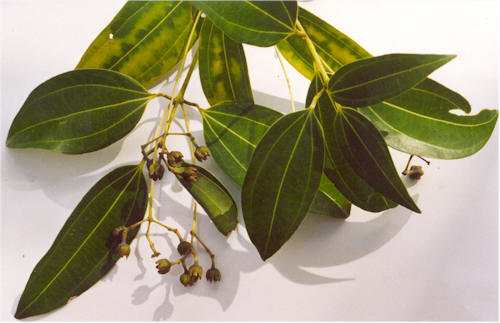Scientific name: Cinnamomum verum
Common Names: True Cinnamon, Sri Lanka Cinnamon, Ceylon Cinnamon
Other Species of Cinnamon: C. cassia (Cassia or Chinese cinnamon), C. burmannii (Korintje, Padang cassia, or Indonesian cinnamon), C. loureiroi (Saigon cinnamon, Vietnamese cassia, or Vietnamese cinnamon)
Description
Cinnamon is a small evergreen tree native to Sri Lanka, belonging to the laurel family (Lauraceae), that can grow to a height of 10-15 meters tall. It has ovate, opposite leaves (7–18 cm long), and its small green flowers are borne on many-branched structures called panicles.
Chemistry and Medicinal Properties
Cinnamon essential oil has antimicrobial and anti-inflammatory properties. Cinnamic aldehyde or cinnamaldehyde (65-80% of cinnamon essential oil) is a yellowish liquid that gives cinnamon its characteristic scent and flavor. Other components of cinnamon essential oil are: eugenol, trans-cinnamic acid, hydroxycinnamaldehyde, o-methoxycinnamaldehyde, cinnamyl alcohol and its acetate, limonene, alpha-terpineol, tannins, mucilage, oligomeric procyanidins, and trace amounts of coumarin.
C. cassia differs from C. verum in its eugenol and coumarin content. Coumarin, a substance found only in the cassia species of cinnamon (at 0.45%), is a precursor to coumadin, an anticoagulant. Coumarin can cause kidney and liver damage in mice and rats, and possibly humans if consumed in large amounts.
Cinnamon leaf oil has been found effective at killing mosquito larvae (see: "Cinnamon Oil Kills Mosquitoes" in the links at the bottom of this page).
Research has shown that chewing Big Red chewing gum (which contains cinnamic aldehyde) can kill up to 40% of the bacteria that causes bad breath (see: "Popular Chewing Gum Eliminates Bacteria That Cause Bad Breath" in the links at the bottom of this page).
There is conflicting research relating to cinnamon's ability to help control type 2 diabetes, and so far the data is inconclusive.
Cinnamon essential oil has antimicrobial and anti-inflammatory properties. Cinnamic aldehyde or cinnamaldehyde (65-80% of cinnamon essential oil) is a yellowish liquid that gives cinnamon its characteristic scent and flavor. Other components of cinnamon essential oil are: eugenol, trans-cinnamic acid, hydroxycinnamaldehyde, o-methoxycinnamaldehyde, cinnamyl alcohol and its acetate, limonene, alpha-terpineol, tannins, mucilage, oligomeric procyanidins, and trace amounts of coumarin.
C. cassia differs from C. verum in its eugenol and coumarin content. Coumarin, a substance found only in the cassia species of cinnamon (at 0.45%), is a precursor to coumadin, an anticoagulant. Coumarin can cause kidney and liver damage in mice and rats, and possibly humans if consumed in large amounts.
Cinnamon leaf oil has been found effective at killing mosquito larvae (see: "Cinnamon Oil Kills Mosquitoes" in the links at the bottom of this page).
Research has shown that chewing Big Red chewing gum (which contains cinnamic aldehyde) can kill up to 40% of the bacteria that causes bad breath (see: "Popular Chewing Gum Eliminates Bacteria That Cause Bad Breath" in the links at the bottom of this page).
There is conflicting research relating to cinnamon's ability to help control type 2 diabetes, and so far the data is inconclusive.
Culinary Uses
The inner bark of the cinnamon tree is used to make the spice cinnamon. This bark is harvested 2-3 years after the tree is planted, it is then dried and rolled up to form sticks (called "quills") or ground into a powder. Cinnamon is slightly bitter and has a hot spicy aromatic flavor and scent. It is used in many recipes as a flavoring and condiment, especially in desserts and spicy drinks (such as apple cider and hot cocoa). It can be used to spice up fruits, breads, candies, curries, and cereals, among other things. In Mexico, cinnamon is a common ingredient in chocolate. Most spice marketed in the U.S. as cinnamon is from C.cassia, rather than true cinnamon (C.verum). Cassia has a more bitter taste than true cinnamon (which has a slightly sweet flavor) and its quills of bark have two curls, while C.verum curls into a single spiral.
Pictures
Leaves and flowers of true cinnamon (C. verum)
The raw bark of C. verum that is used to make the spice.
LINKS FOR MORE INFORMATION:
EOL: Encylopedia of Life
PLANTS Profile
Chemistry Daily - Cinnamon
Drugs.Com: Cinnamon
Popular Chewing Gum Eliminates Bacteria That Cause Bad Breath
Cinnamon Oil Kills Mosquitoes


No comments:
Post a Comment